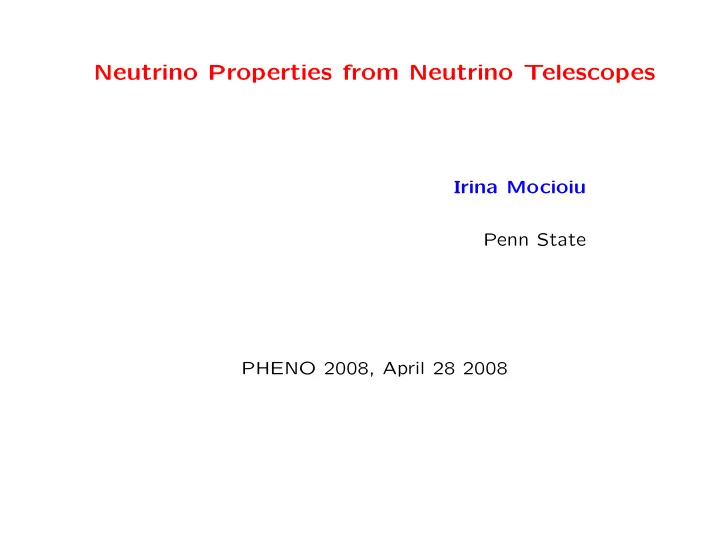

Neutrino Properties from Neutrino Telescopes Irina Mocioiu Penn State PHENO 2008, April 28 2008
IceCube
What to look for? • Point sources • Diffuse fluxes • from sources • from cosmic ray interactions • from dark matter annihilation • ... • Correlations with other observations: cosmic rays, gamma rays...
Lessons for Particle Astrophysics Weak interactions - access to dense, violent envirenoments - test mechanism powering astrophysical sources - cosmic ray acceleration processes - cosmic ray propagation and intergalactic photon backgrounds - ... Lessons for Particle Physics high energies, beyond those accessible in colliders, etc. weak interactions - neutrino interaction cross-sections (in Standard Model!) - neutrino properties - new interactions/particles - dark matter - ...
How to do it? - energy distributions - angular distributtions - flavour composition Observables • Muon tracks: ν µ CC interactions: ν µ + N → µ + X • Electromagnetic showers: Tau decay: τ → e + ¯ ν e + ν τ ν e CC interactions: ν e + N → e + X • Hadronic showers Tau decay: τ → ν τ + X ν τ NC interactions: ν τ + N → ν τ + X ν τ CC interactions: ν τ + N → τ + X ν e,µ NC and CC interactions
Deep Core Array • motivation: galactic sources, dark matter annihilation • need to reduce large cosmic muon background • dense phototube coverage region • in the deep ceter region of IceCube • low energy threshold
Atmospheric Neutinos Cosmic ray π 0 π + µ + ∼ 30km e + ν µ ν e ¯ ν µ Underground ν e , ,¯ ν e , , ν µ , ¯ ν µ detector N ( ν µ +¯ ν µ ) • Expect: ν e ) ∼ 2 at low energy N ( ν e +¯ ∼ isotropic • background to many IceCube searches
Summary of Experimental Results • Solar Neutrinos: ν e → ν x , x = µ, τ + reactor antineutrinos ∆ m 2 7 . 6 × 10 − 5 eV 2 ≃ sol tan 2 θ sol 0 . 45 ≃ • Atmospheric Neutrinos: ν µ → ν x , x = τ + accelerator neutrinos ∆ m 2 2 . 5 × 10 − 3 eV 2 ≃ atm sin 2 2 θ atm 1 ≃ • Reactor antineutrinos: ¯ ν e �→ ¯ ν e sin 2 2 θ reactor < ∼ 0 . 1 for ∆ m 2 ∼ 10 − 3 eV 2
Three flavors s 13 e − iδ c 12 c 13 s 12 c 13 − s 12 c 23 − c 12 s 23 s 13 e iδ c 12 c 23 − s 12 s 23 s 13 e iδ s 23 c 13 s 12 s 23 − c 12 c 23 s 13 e iδ − c 12 s 23 − s 12 c 23 s 13 e iδ c 23 c 13 ∆ m 2 21 = ∆ m 2 ∆ m 2 32 = ∆ m 2 sol , atm θ 12 = θ sol , θ 13 = θ reactor , θ 23 = θ atm , δ We want to measure: • θ 13 • hierarchy (sign of ∆ m 2 atm ) • CP violation ( δ ) large effort to build new accelerator experiments for this purpose use matter effetcs
Neutrino Oscillations in IceCube µ like fully contained events Angular distribution: • cos θ ∈ (0 , 1) atmosperic flux normalization • cos θ ∈ ( − 0 . 9 , 0) + main oscillation signal (∆ m 2 32 , θ 23 ) • cos θ ∈ ( − 1 , − 0 . 9) + matter effects ( θ 13 , hierarchy, CP) Energy distribution: • E ≤ 40GeV: neutrino oscillations • 50 GeV ≤ E ≤ 5 TeV atmospheric neutrino flux • E ≥ 10 TeV: Earth density profile • χ 2 fit to discriminate between normal and inverted hierarchy
Normal versus inverted hierarchy: O. Mena, I. M., S. Razzaque Normal � 100 Mt yr, Θ 23 � 45 � , no systematics � Inverted � 100 Mt yr, Θ 23 � 45 � , no systematics � Normal � 100 Mt yr, Θ 23 � 45 � , 10 � systematics � 150 150 150 100 90 � 90 � 90 � 90 � 100 90 � 90 � 90 � 90 � 90 � 90 � 90 � 90 � 90 � 90 � 100 90 � 90 � 50 99 � 99 � 99 � 99 � 50 99 � 99 � 99 � 99 � 99 � 99 � 99 � 99 � 99 � 99 � 50 ∆ cp ∆ cp ∆ cp 0 0 0 � 50 � 50 95 � 95 � 95 � 95 � � 50 95 � 95 � 95 � 95 � 95 � 95 � 95 � 95 � 95 � 95 � � 100 � 100 � 100 68 � 68 � 68 � 68 � 68 � 68 � 68 � 68 � 68 � 68 � 68 � 68 � 68 � 68 � 68 � 68 � � 150 � 150 � 150 0.00 0.02 0.04 0.06 0.08 0.10 0.12 0.14 0.00 0.02 0.04 0.06 0.08 0.10 0.12 0.14 0.00 0.02 0.04 0.06 0.08 0.10 0.12 0.14 sin 2 2 Θ 13 sin 2 2 Θ 13 sin 2 2 Θ 13
Lots to learn from: - astrophysical neutrinos - long baseline experiments In the meantime: use atmospheric neutrinos in IceCube to determine neutrino oscillation parameters!
Recommend
More recommend